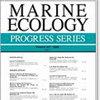Temperature-dependent hypoxia tolerance of purple sea urchin Strongylocentrotus purpuratus across biogeography and ontogeny
IF 2.2
3区 环境科学与生态学
Q2 ECOLOGY
引用次数: 0
Abstract
ABSTRACT: Ocean warming is increasing organismal oxygen demand, yet at the same time the ocean’s oxygen supply is decreasing. For a patch of habitat to remain viable, there must be a minimum level of environmental oxygen available for an organism to fuel its metabolic demand—quantified as its critical oxygen partial pressure ( pO2crit). The temperature-dependence of pO2crit sets an absolute lower boundary on aerobically viable ocean space for a species, yet whether certain life stages or geographically distant populations differ in their temperature-dependent hypoxia tolerance remains largely unknown. To address these questions, we used the purple sea urchin Strongylocentrotus purpuratus as a model species and measured pO2crit for 3 populations of adult urchins (Clallam Bay, WA [n = 39], Monterey Bay, CA [91], San Diego, CA [34]) spanning 5-22°C and for key embryonic and larval developmental phases (blastula [n = 11], gastrula [21], prism [31], early-pluteus [21], late-pluteus [14], settled [12]) at temperatures of 10-19°C. We found that temperature-dependent hypoxia tolerance is consistent among adult populations exposed to different temperature and oxygen regimes, despite variable basal oxygen demands, suggesting differential capacity to provision oxygen. Moreover, we did not detect evidence for a hypoxia tolerance bottleneck for any developmental phase. Earlier larval phases are associated with higher hypoxia tolerance and greater temperature sensitivity, while this pattern shifts towards lower hypoxia tolerance and reduced temperature sensitivity as larvae develop. Our results indicate that, at least for S. purpuratus, models quantifying aerobically viable habitat based on pO2crit-temperature relationships from a single adult population will conservatively estimate viable habitat.紫色海胆(Strongylocentrotus purpuratus)在生物地理学和个体发育过程中对低氧的耐受性与温度有关
摘要:海洋变暖正在增加生物对氧气的需求,但与此同时,海洋的氧气供应却在减少。要使一片栖息地保持活力,必须有最低水平的环境氧气供生物体满足其新陈代谢需求--用临界氧分压(pO2crit)来量化。pO2crit 与温度有关,它为一个物种的有氧生存海洋空间设定了一个绝对的下限,但某些生命阶段或地理上相距遥远的种群是否在其与温度有关的缺氧耐受性方面存在差异,这在很大程度上仍是未知数。为了解决这些问题,我们以紫色海胆 Strongylocentrotus purpuratus 为模式物种,测量了 3 个成年海胆种群(华盛顿州克拉勒姆湾 [n = 39]、加利福尼亚州蒙特雷湾 [91] 和加利福尼亚州圣迭戈 [34] )的 pO2crit、加州圣迭戈 [34])的 pO2crit,以及温度为 10-19°C 的关键胚胎和幼体发育阶段(胚泡 [n = 11]、胚乳 [21]、棱柱 [31]、早期黄体 [21]、晚期黄体 [14]、定居 [12])的 pO2crit。我们发现,尽管基础需氧量不同,但暴露于不同温度和氧气条件下的成体对温度依赖性缺氧的耐受性是一致的,这表明提供氧气的能力存在差异。此外,我们没有发现任何发育阶段存在耐缺氧瓶颈的证据。幼虫早期阶段具有较高的缺氧耐受性和较高的温度敏感性,而随着幼虫的发育,这种模式会向较低的缺氧耐受性和较低的温度敏感性转变。我们的研究结果表明,至少对于紫斑蝶来说,根据单一成虫种群的 pO2crit-温度关系来量化有氧生存栖息地的模型,可以保守地估计有氧生存栖息地。
本文章由计算机程序翻译,如有差异,请以英文原文为准。
求助全文
约1分钟内获得全文
求助全文
来源期刊

Marine Ecology Progress Series
环境科学-海洋学
CiteScore
5.30
自引率
8.00%
发文量
238
审稿时长
3 months
期刊介绍:
The leading journal in its field, MEPS covers all aspects of marine ecology, fundamental and applied. Topics covered include microbiology, botany, zoology, ecosystem research, biological oceanography, ecological aspects of fisheries and aquaculture, pollution, environmental protection, conservation, and resource management.
 求助内容:
求助内容: 应助结果提醒方式:
应助结果提醒方式:


